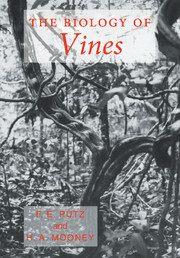Book contents
1 - The distribution and evolution of climbing plants
Published online by Cambridge University Press: 05 November 2011
Summary
Introduction
The classic work on climbers by Schenck (1892, 1893), is focused especially on anatomical features of lianas, but also includes a taxonomic and geographic survey of the occurrence of climbing plants. Such 19th century luminaries as Charles Darwin (1867) were fascinated by the peculiarities of climbing plants. However, despite their obvious importance in the world's flora, especially in tropical forests, climbers have subsequently been generally neglected. As summarized by Jacobs (1976), ‘The ecology of lianas is virtually a blank’. Indeed the significant ecological role played by lianas in tropical forests has only very recently begun to be investigated (e.g. Putz, 1984, 1985; Putz & Chai, 1987). Lianas have been no less neglected by plant collectors: quite probably lianas are the most undercollected of any major habit group of plants.
This overview of climbing plants is based largely on 0.1 ha data sets for plants >2.5 cm in diameter at breast height (dbh). The sampling protocol under which these data were gathered was originally set up specifically to facilitate ecological sampling of lianas, which are notorious for clumped distributions related to rampant vegetative reproduction (Peñalosa, 1984; Putz, 1984; Gentry, 1985). Each sample consists of ten 2 × 50 m narrowly rectangular plots set up end to end or separated by c. (10-)20 m, thus covering a relatively large area of forest that exceeds in scale the frequent ‘patches’ of single liana species that presumably derive from vegetative reproduction.
- Type
- Chapter
- Information
- The Biology of Vines , pp. 3 - 50Publisher: Cambridge University PressPrint publication year: 1992
- 65
- Cited by

